Five gender balances and imbalances that define international education in the United States

More than half a million female international students are studying in the United States, but women make up a smaller proportion of the total international student population compared to the total number of American students who study overseas.
519,000 female international students enrolled in universities in the United States during the 2017-18 academic year. This was significantly more than the total 332,700 men and women who left the US to study abroad the year before. Relatively, however, fewer women are coming to the US to study than are leaving. While women account for roughly 43% of inbound students, they make up 67% of the outbound students.
In sending more female than male students to study abroad, the US diverges from the slight majority of countries—about 52% worldwide—whose outbound international student cohorts favor male students. Moreover, when compared to other countries that send greater proportions of female students abroad, such as Japan and Russia, the gender delta in the US is substantially greater. Although both countries received lower Gender Equality Indices than the US from the Organisation for Economic Cooperation and Development (OECD), Japan and Russia send female students to the States in proportions of 54%, and 57%, respectively—far more balanced with the proportions of male students they send.
Why, then, do women outpace men when it comes to study abroad in the US? Historical explanations have pointed to the difficulties study abroad poses to timely degree completion in male-dominated fields (i.e. STEM and business) and misconceptions that employability is better served by resume-building at home. But these are just that—misconceptions. In a world where the largest groups of US students studying abroad are pursuing STEM and business degrees, and in a career landscape that places increasing importance on global experience, male students may stand to learn a thing or two from their female counterparts who are more inclined to pursue transformative educational experiences abroad.
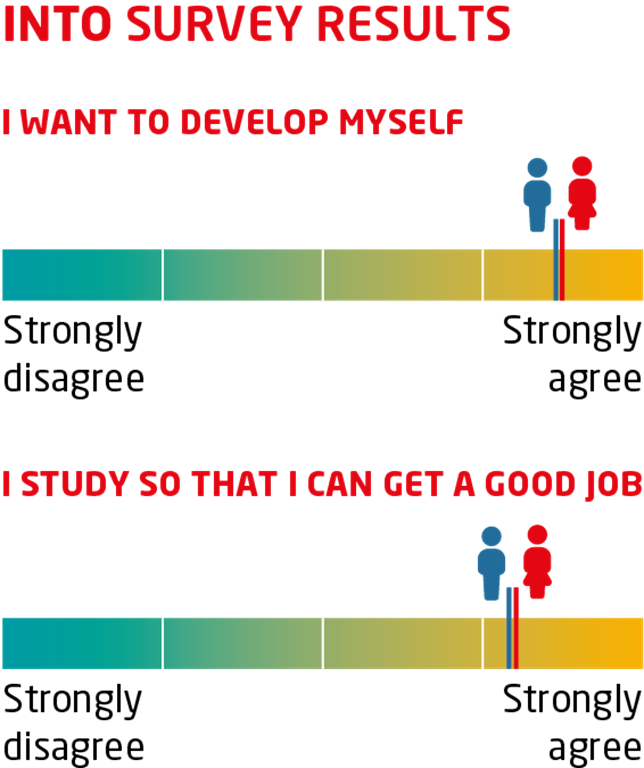
Although female and male international students in the US have similar motivations to study abroad, women are slightly more motivated to develop themselves and launch good careers.
In 2017, INTO partnered with iGraduate to conduct a survey of students commencing their studies in our US and UK centers. The women and men who participated in the survey largely shared in their motivations to study abroad—they were equally determined to have a positive impact on the world, and they were equally concerned with career preparedness.
There were two prompts, however, in regard to which women demonstrated a slightly stronger motivation than men. When asked to rank their motivation to develop themselves on a scale of 1 to 4 (1 being unmotivated and 4 being highly motivated), the average female INTO student indicated a 3.496-level motivation, as opposed to the males’ average response of 3.457. At the same time, when asked to rank their motivation to study abroad so they could get a good job, women indicated a 3.208-level motivation, compared to men’s average response of 3.164.
Women, therefore, share equally strong, if not stronger, drives to study abroad as men. Surely where motivation to improve self and to prepare for good careers is equal between the sexes, so too should be the opportunity to do so.
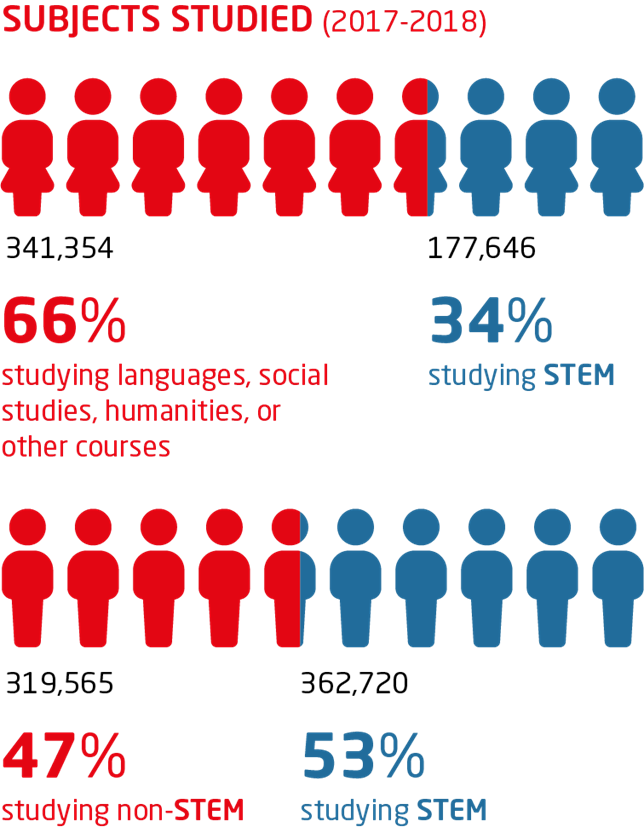
Only one third of female international students in the US choose to pursue STEM.
65% of female international students studying in the US choose to study languages, social studies, humanities, or other courses, leaving just 34% who choose STEM subjects. Compare this to the 53% of male international students who study STEM and the 47% who pursue non-STEM subjects.
These splits are in line with the OECD’s Program for International Student Assessment (PISA) findings that men tend to outperform women in science and are more likely to graduate with STEM degrees. The OECD attributes this to the fact that women are more likely to excel in other subjects like reading and are therefore more likely to pursue those fields of study. However, the OECD also notes that fewer women around the world pursue careers in STEM fields than are expected to, this based on PISA 2015 data that indicates that more women were high performers in science and indicated great interest in science than graduated with a STEM degree. 41% of high performers surveyed were women, compared to 28% of those who earned a STEM degree between 2012 and 2015.
Given what we have learned about female international students thus far—that they are inclined to seek out transformative educational experiences and are motivated by self-development and career preparedness—this underrepresentation suggests a need to change the ways in which teachers ask female students to approach STEM.
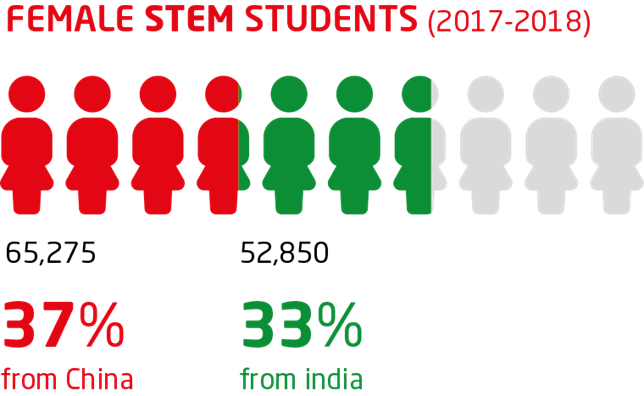
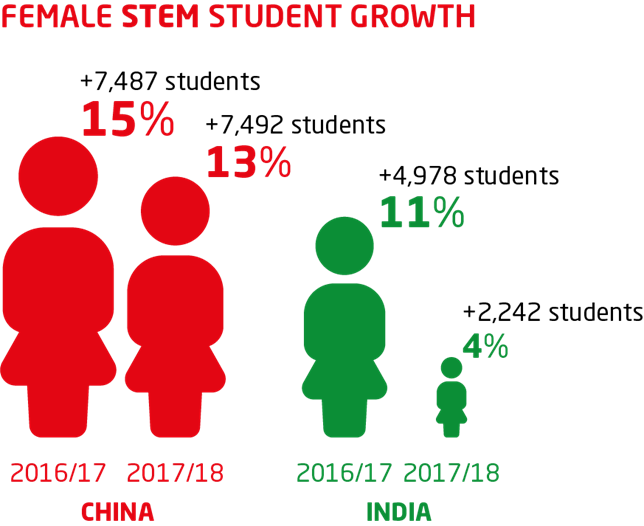
Two thirds of the 177,646 female international students pursuing STEM degrees in the US hail from two countries: China and India.
37% of female international STEM students in the US originate from China and 30% hail from India. Certainly, this comes as no surprise given historical enrollment trends and the fact that these two countries are the largest senders of international students to the US.
However, growth in the total number of female STEM students enrolling in US institutions from these countries has slowed over the last two years. In China, the slow-down was a less significant drop from 15% growth between 2016 and 2017 to 13% between 2017 and 2018. In India, however, the slow-down was more significant, with a dramatic drop from 11% growth between 2016 and 2017 to 4% between 2017 and 2018. Slowed growth may be attributed to any of several reasons, including increased funding for and prominence of STEM programs in China and India, international perceptions of the US as a welcoming study destination, and, especially where Indian students are concerned, increased visa denial rates. With heightened competition in STEM research from other nations, and with the number of STEM jobs available in the US growing every day, safeguarding the influx of talent into US universities constituted in these two massive cohorts is more important than ever.
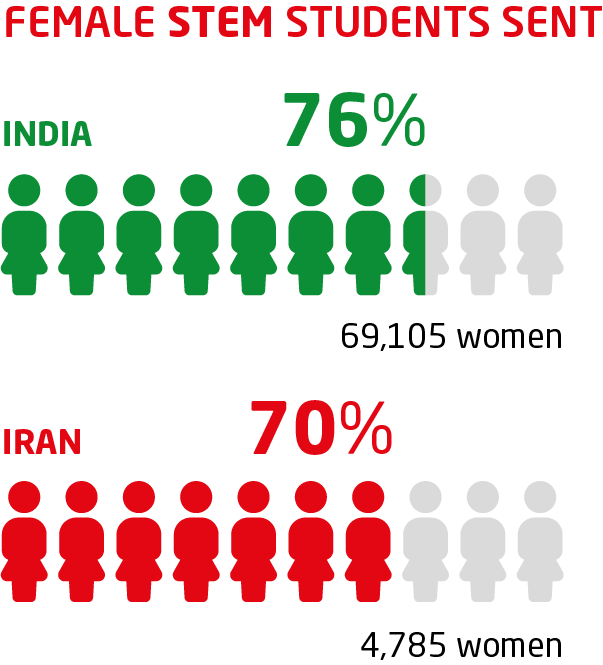
Iran and India send significantly larger proportions of female STEM international students to the US than any other country.
Two of the top five countries for sending STEM students to the US, India and Iran, also send female STEM students to the US in greater proportions than any other country. Although growth in female international STEM enrollments from India is slowing, 76% of the 69,105 Indian women studying in the US are pursuing STEM degrees, while 70% of the 4,785 Iranian women studying in the US are doing the same.
Relatively, this is twice as many women pursuing STEM in the US as one would expect to find from a given country, a difference that, in the case of Iran, results from the emphasis secondary education places on the applied sciences. Indeed, the proportion of outbound female STEM students in Iran matches the number of female STEM students who pursue their degree in-country — 70% in 2015. This same narrative, however, does not define the trend of STEM-pursuing female students in India, a country where women are largely underrepresented in STEM fields. Only 14% of STEM researchers in India are women, compared to the global average of 28.4%.
Nevertheless, the relatively large cohort of female STEM students coming to the US from India constitutes a group of women defined by self-efficacy and determination to pursue educational and career opportunities not immediately available in their home country. Is it not, then, must the job of international educators in the US—and, for that matter, around the world—to meet female international students where they are, matching their ambition and fostering their engagement with domestic students so that both cohorts might experience an enriched, global, empowering education? We certainly think so.